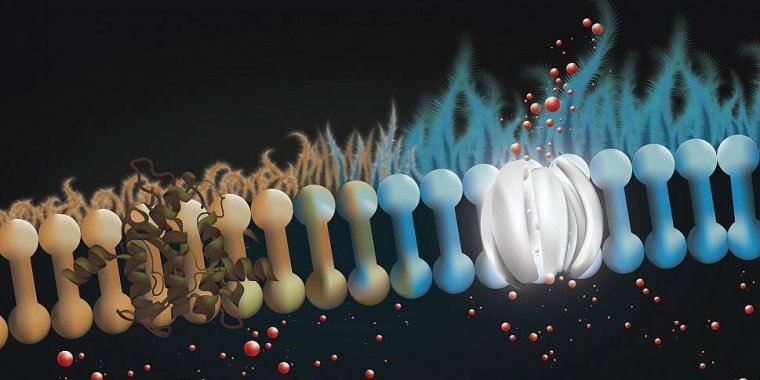| Health / Health News |
Scientists find new approach that shows promise for treating cystic fibrosis
In studies using human cells and animals models, the researchers found that the medication, called amphotericin, helps lung cells function in a way that could make it easier for patients to fight chronic bacterial lung infections that are a hallmark of the disease.

In people with cystic fibrosis, a protein that releases a key infection-fighting agent (red spheres), is missing or defective (brown ribbon). Amphotericin (white structure) can form channels to release bicarbonate, restoring the antibiotic properties of the airway surface liquid, which plays a key role in maintaining lung health. Photo: Rebecca Schultz, Carle Illinois College of Medicine
If human studies validate the findings, the use of the drug could be good news to the more than 70,000 worldwide who live with cystic fibrosis, a disease with no cure and few treatment options. It holds special promise for a subset of patients, about 10 percent of the people with cystic fibrosis, who do not respond to any treatment.
The really exciting news is that amphotericin is a medicine that’s already approved and available on the market.
Cystic fibrosis is caused by a defect in a gene called CFTR (cystic fibrosis transmembrane conductance regulator). This gene normally makes a protein that controls or channels the movement in and out of cells of such materials as salt, bicarbonate, and water—all of which are important to normal lung function.
In people with cystic fibrosis, however, the defective gene makes a protein that is itself defective, causing the accumulation of acidic and sticky mucus that not only clogs the lungs and makes it hard to breathe, but also makes the lungs vulnerable to bacterial infection.
While some treatments are currently available, they are limited because different people have different types of mutated proteins, and because 10 percent of people with cystic fibrosis make no protein at all. But amphotericin has the potential to work regardless of the kind of mutation, and even when the protein is missing.
In their studies, the researchers used lung tissue from patients with cystic fibrosis, as well as pig models of cystic fibrosis, and found that amphotericin spurred a host of changes associated with improved lung function — restoration of pH levels, improved viscosity, and increased antibacterial activity, among others.
The researchers noted that amphotericin can be delivered directly to the lungs to avoid common side effects. They cautioned that more experimental studies are needed before the drug is safe to treat cystic fibrosis in people. But experts are hopeful. (National Institutes of Health)
YOU MAY ALSO LIKE




